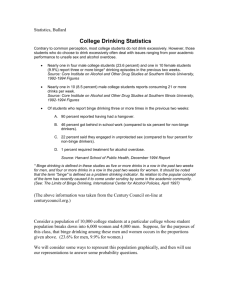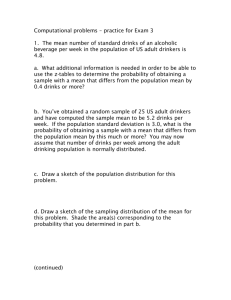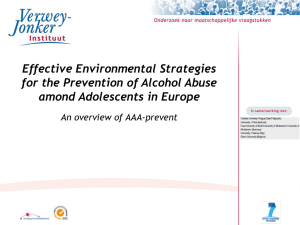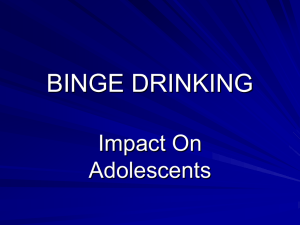Screening, Brief Intervention, Referral, and Treatment (SBIRT)
advertisement
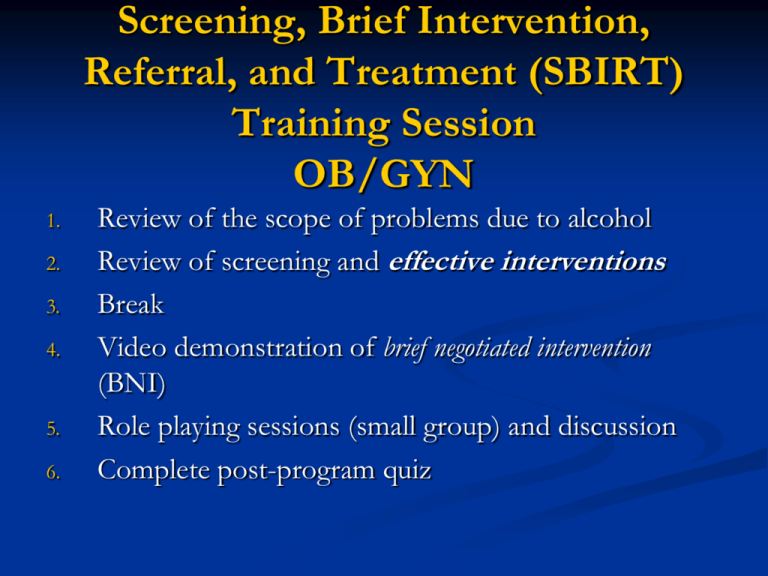
Screening, Brief Intervention, Referral, and Treatment (SBIRT) Training Session OB/GYN 1. 2. 3. 4. 5. 6. Review of the scope of problems due to alcohol Review of screening and effective interventions Break Video demonstration of brief negotiated intervention (BNI) Role playing sessions (small group) and discussion Complete post-program quiz Several Truths Practitioners are reluctant to screen and intervene The primary care visit is an opportunity for intervention Treatment works! Timely referral is effective Alcohol: Scope of the Problem Why should we care? Alcohol is the most commonly used drug in the United States Alcohol Fast Facts Alcohol related deaths 75,000/year Annual economic cost $185 billion Homicides (alcohol involved) 60-70% Suicides (alcohol involved) 40% Fatal motor vehicle accident 50% A risk factor for medical conditions Hypertension, stroke, diabetes, liver, GI disease Alcohol Fast Facts Major risk factor for all categories of injury Problem Injuries drinkers per year 2x Hospitalizations 4x for injuries hospitalizations for injury Even one alcohol-related visit predicts continued problem drinking Young Adults Alcohol use in the past month 17% 33% 47% Binge drinking (>5drinks in a row) in last 2 weeks 8th grade 10th grade 12th grade 8th grade 10th grade 12th grader 11% 21% 28% Drivers between the ages of 16-25 account for 30% of alcohol-related fatalities Johnston, O’Malley, Bachman, et al. Monitoring the Future Survey, 2005. www.monitoringthefuture.org Adults over 18 years 10 million (5%) 40 million (20%) 70 million (35%) 80 million (40%) dependent drinkers high risk drinkers moderate drinkers abstain National Longitudinal Alcohol Epidemiologic Survey, 1992 High risk “At-risk” drinkers Issues unique to pregnancy Prevalence of alcohol use Prevalence of use (age 18-44)-non pregnant Binge drinking in a previous month Binge drinking in a previous month Many not using contraception 11% 2% 55% 13% >50% Pregnancy is a unique time, where motivation to reduce alcohol use may be higher. 74% of women stop drinking during pregnancy. Issues unique to pregnancy No known safe levels of alcohol intake No exact dose-response relationship Binge drinking may be more concerning than similar volumes over time. Increased stillbirth rate <1 drink per week >/=1 drink per week 1.37 per 1000 births 8.83 per 1000 births Current U.S. recommendation: abstinence Fetal alcohol syndrome (most severe) Prevalence with heavy drinkers Offspring issues: Leading cause of developmental delay in the US. Growth problems (<10% at any point in time) Facial dysmorphia 10-50% Microcephaly Smooth philtrum, thin vermillion border, small palpebral fissures Maxillary hypoplasia Central nervous system abnormalities Average IQ 63 Fine motor dysfunction Nation’s Public Health Agenda: Healthy People 2010 Increase the proportion of persons who are referred for follow-up care for alcohol problems, drug problems, or suicide attempts after diagnosis or treatment for one of these problems in the emergency department Ambulatory medical care survey SCREENING Screening for Alcohol use and abuse ACOG Committee Opinion: Dec 2008 “Obstetrician-gynecologists have an ethical obligation to learn and use a protocol of universal screening questions, brief intervention, and referral to treatment in order to provide patients with medical care that is state-of-the-art, comprehensive and effective. Screening allows for early and effective treatment Screening is cost-effective (saves $7 for every $ spent) Primary care visit is an ideal opportunity to screen and intervene as necessary UNIVERSAL SCREENING WIDENS THE NET ABSTAINERS & MILD DRINKERS (70%) MODERATE (20%) at risk drinkers SEVERE (10%) Specialized Treatment Brief Intervention Primary Prevention ASK Current Drinkers On average, how many days per week do you drink alcohol? On a typical day when you drink, how many drinks do you have? What is the maximum number of drinks you had on a given occasion last month? Remember that a “standard drink” consists of: Screen Positive: NIAAA Guidelines Pregnant women 0 drinks ASK Current Drinkers CAGE C A G E Cut Down Annoyed Guilty Eye Opener Detection and Referral Does it matter? What do we do? ABSTAINERS & MILD DRINKERS (70%) MODERATE (20%) at risk drinkers SEVERE (10%) Specialized Treatment Brief Intervention Primary Prevention Brief negotiated intervention (BNI): A motivational interview For the “At-risk drinker” Principles of Motivational Interviewing Ask for permission to discuss problems Express empathy and avoid arguments Develop discrepancies Roll with resistance and provide personalized feedback Help patients understand the differences between their behavior and their goals “Reflective listening” Support self-motivation Motivational Interviewing: A Tool for Behavior Change ACOG Committee Opinion: Jan 2009 The goal is to “help patients identify and change behaviors that place them at risk” “motivational interviewing to everyday patient interactions has been proved effective in eliciting “behavior change” “ACOG encourages the use of motivational interviewing as one approach to elicit behavior change.” Fleming et al JAMA 1997 “Brief physician advice for problem alcohol drinkers: a randomized control trial in community-based primary care practices” Randomized controlled trial 17 practices with 64 physicians Intervention included: 723 patients Educational workbook, 15 minute visits one month apart x 2 Nurse follow-up calls x 2 (2 weeks after the visit) Fleming et al JAMA 1997 Results at 12 months (n=723) Alcohol consumption reduced with intervention: Intervention group 19.1 drinks/wk 11.5 Control group 18.9 drinks/wk 15.2 Episodes of binge drinking during prior 30 days: Intervention group 5.7 3.1 Control group 5.3 4.2 Brief Interventions are Effective… How do we do it? Video: Scenario 1 Components of the Brief Negotiated Intervention 1. Raise the Subject 2. Provide Feedback 3. Enhance Motivation 4. Negotiate and Advise Step 1: Raise the Subject Establish Rapport Raise the subject of alcohol use Step 1: Establish Rapport To understand the patient’s concerns and circumstances “That car accident must have been scary” “Having your boyfriend hurt you must be awful” To explain the providers concern/role I am concerned regarding the effect alcohol may be having on you. To avoid a judgmental stance Step 1: Raise the subject Get the patient’s agreement to talk about the alcohol or drug use Talk about the pros and cons of their use/abuse Do you mind if we just take a few minutes to talk about your alcohol/drug use? What is it that alcohol does for you? Re-state what they have said regarding the pros and cons Troubleshooting: What if the patient does not want to talk about their use/abuse ? “ Okay, I see you aren’t ready to talk about this today. Remember that we are here 24 / 7 if you change your mind” Step 2: Provide Feedback Review patient’s drinking patterns “From what I understand you are drinking…” Step 2: Provide Feedback Make connection to the visit if possible If the patient sees a connection: “What connection (if any) do you see between your drinking and this visit?” Reflect what they have just said. If the patient does not see a connection: Help make a connection with facts “Alcohol can slow your reflexes and predispose you to accidents” “Alcohol may impair your judgment and ….. Step 2: Provide Feedback Compare to National Norms and offer NIAAA guidelines (show them) Step 3: Enhance Motivation: Assess the readiness for change “On a scale of 1-10 (1 being not ready and 10 being very ready) how ready are you to change any aspect your drinking patterns?” 1 2 3 4 5 6 7 8 9 10 Step 3: Enhance Motivation Develop Discrepancies • If patient indicates she is ready for change: > 2 : “Why did you choose that number and not a lower one? What are some reasons that you are so motivated to change.” • If patient indicates she is not ready for change: < 1: “Have you ever done anything that you wish you hadn’t while drinking: What would make this a problem for you.” Discuss pros and cons Step 3: Enhance Motivation Develop Discrepancy Explore Pros and Cons Help the patient identify the discrepancy between present behavior and important goals Use the discrepancy as a change motivator Let the patient name the problem and offer solutions The Ready Patient Help the patient to: Name a solution for themselves Choose a course of action Decide how to achieve it Encourage patient choice Not Ready for Change Don’t Use shame or blame Preach Label Stereotype Confront Do Offer information, support and further contact Present feedback and concerns, if permitted Negotiate: “What would it take you to consider a change ?” Not Ready for Change Avoid arguments Counter productive Defending breeds defensiveness Perceptions can be shifted Labeling is unnecessary Resistance is a signal to change strategies Rolling with resistance Unsure patients Don’t Jump ahead Give advice Expect argument about change Do Explore pros & cons “help me to understand what alcohol does for you” “Are there things you don’t like about your alcohol use?” Step 4: Negotiate and Advise Reinforce what the patient has stated are her goals. Negotiate the goal/Elicit a response “What is the next step?” Give advice “So… you would like to reduce your drinking to prevent….” “If you can stay within the limits you just mentioned you will be less likely to have a car accident..” Summarize “This is what I heard you say.. Step 4: Negotiate and Advise Provide handouts Drinking agreements Other support sources Step 4: Negotiate and Advise Suggest primary care follow up or referral Social worker Psychiatric services Discharge sheet of possible centers and / or programs and information Thank patient for their time Summary Alcohol problems are common, identifiable and treatable disorders Knowledge and skills for screening and intervention can be learned VIDEO nd 2 and rd 3 scenario Discussion To what degree do you discuss alcohol use with your patients? Discussion Do you think you can incorporate SBIRT (Screening, Brief Negotiated Interview, and Referral to Treatment) into your practice? If so, why? What parts seem to work well? If not, why not? What barriers exist? Small Groups
